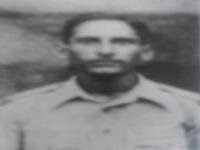Col Dilbag Dabas (Retd)
“Jung me Hindustani sipahi hathiyar nahi dalta, aakhri saans tak surrender nahi karta. Patthar ki aad mat lo, saamne aao,” was Sepoy Kanshi Ram’s rebuff to the Chinese Commander during the 1962 India-China War.
Kanshi Ram, son of Narotam Ram, was born on July 1, 1938, in Duhan village of Mandi district of the then undivided Punjab. The recruitment of men in the armed forces from Mandi district is the highest among all districts of Himachal. Son of an ex-serviceman, Kanshi followed into the footsteps of his father and joined the Punjab Regiment, which was his father’s regiment, too. On January 18, 1958, Kanshi was Sepoy Kanshi Ram of the 9th Battalion of the Punjab Regiment.
The myth ‘Hindi-Chini bhai bhai’ went for a toss in the morning hours of October 10, 1962, when a Chinese Infantry Regiment (equivalent to Indian Army brigade of three battalions) rolled down south of Thag La ridge in Kameng division of North East Frontier Agency (NEFA) and attacked the Indian Army holding hastily prepared defenses on the south bank of the Nam Ka Chu river. The Indian troops holding the defenses were never so ill-equipped, ill-clothed and ill-acclimatised to fight at heights ranging from 15,000 feet to 20,000 feet in an extreme cold climate.
To minimise the drastic fallouts of the decisions taken at the highest level, the Army was not even made to fight for effect. While withdrawal is also an operation of war, but during 1962 India-China war in NEFA, most of the times, it was resorted to based on decisions which defied military logic. But some battalions, despite all possible odds, did fight and took a heavy toll on the Chinese till they were out-numbered almost 5 to 1 and were ordered to withdraw. The 9th Battalion of the Punjab Infantry Regiment was one such battalion, whose men did fight and displayed the stuff Punjabis are made of.
Sepoy Kanshi Ram, just about 24, nurtured by the Himachal soil which catches them young and transforms them into brave-hearts, displayed his Himachali grit and earned for himself the Maha Vir Chakra, the second highest military decoration in the country.
In the meantime, another wave of the Chinese closed in on him. This time, Kanshi Ram did not retaliate with his Indian made Light Machine Gun, but tested the Chinese made automatic rifle on the Chinese and realised that the weapon was effective against anyone in the fire line. And this time in the line of fire were 30 Chinese soldiers martyred by their home-made weapon. That was the first weapon made in China captured by the 7 Indian Infantry Brigade and effectively used against the manufactures during 1962 India-China war in NEFA.
For his self-confidence, dogged determination and steadfastness in the face of the enemy in superior strength, Sepoy Kanshi Ram was awarded the Maha Vir Chakra.”
A lot has been written about the 1962 war with China, some still remains classified, but it continues to be one of our least understood historical events. Shiv Kunal Verma, a military historian of repute, rightly calls the 1962 war as an unmitigated disaster in his book, aptly titled “1962, the war that wasn’t”.
There are numerous examples of men and officers, who tried to take a stand during the 1962 debacle, but were let down by their political and military superiors. But there were still men like Sepoy Kansi Ram, who went beyond the call of duty and proved that a Hindustani Sepoy can go to any extreme to defend the motherland.
The battle account of his bravery...
"On October 10, 1962, the post of Tseng Jong in NEFA was attacked by approximately 500 Chinese. Disregarding the heavy enemy fire, Sepoy Kanshi Ram effectively covered the right approach to his post with accurate fire from his Light Machine Gun. Although seriously injured, Kanshi Ram did not waver and kept inflicting heavy casualties on the advancing enemy making them to retreat. After giving him first aid and attending to his wounds, his Company Commander Major Mahinder Singh Chaudhary (earned Maha Vir Chakra, posthumous in the same battle) wanted him to be evacuated since his injuries were serious and he was bleeding profusely, but Kanshi refused evacuation. He tied a bandage on his wound tightly to stop the blood from coming out and remained at his post and continued to fire onto the enemy. His post was once again attacked by another wave of the Chinese infantry, this time with greater intensity of small arms fire. Despite his injury, Sepoy Kanshi Ram brought his own machine gun into action. Despite suffering casualties, the enemy waves kept on advancing and closing in on his post. A Chinese officer along with 40 jawans approached close to Kanshi Ram and shouted from behind a boulder "hathiyar dalo, surrender karo". In reply, Sepoy Kanshi Ram, jumped out of his trench, grappled with the officer, killed him and snatched his automatic rifle, but before taking this near suicidal attempt, he had warned the Chinese Commander: "Hindustani Sepoy hathiyar nahi dalta, aakhri saans tak surrender nahi karta. Patthar ki aad mat lo, saamne aao".
Maha Vir Of Mandi
- Sepoy Kanshi Ram, just about 24, nurtured by the Himachal soil which catches them young and transforms them into brave-hearts, displayed his Himachali grit and earned for himself the Maha Vir Chakra.
- Maha Vir Chakra, the second highest military decoration in India, next only to the Param Vir Chakra, is awarded for conspicuous or daring act of bravery, or self-sacrifice in the face of the enemy on land, at sea or in the air.
(The writer is a veteran Gunner, 6 Field Regiment)
Unlock Exclusive Insights with The Tribune Premium
Take your experience further with Premium access.
Thought-provoking Opinions, Expert Analysis, In-depth Insights and other Member Only Benefits
Already a Member? Sign In Now










